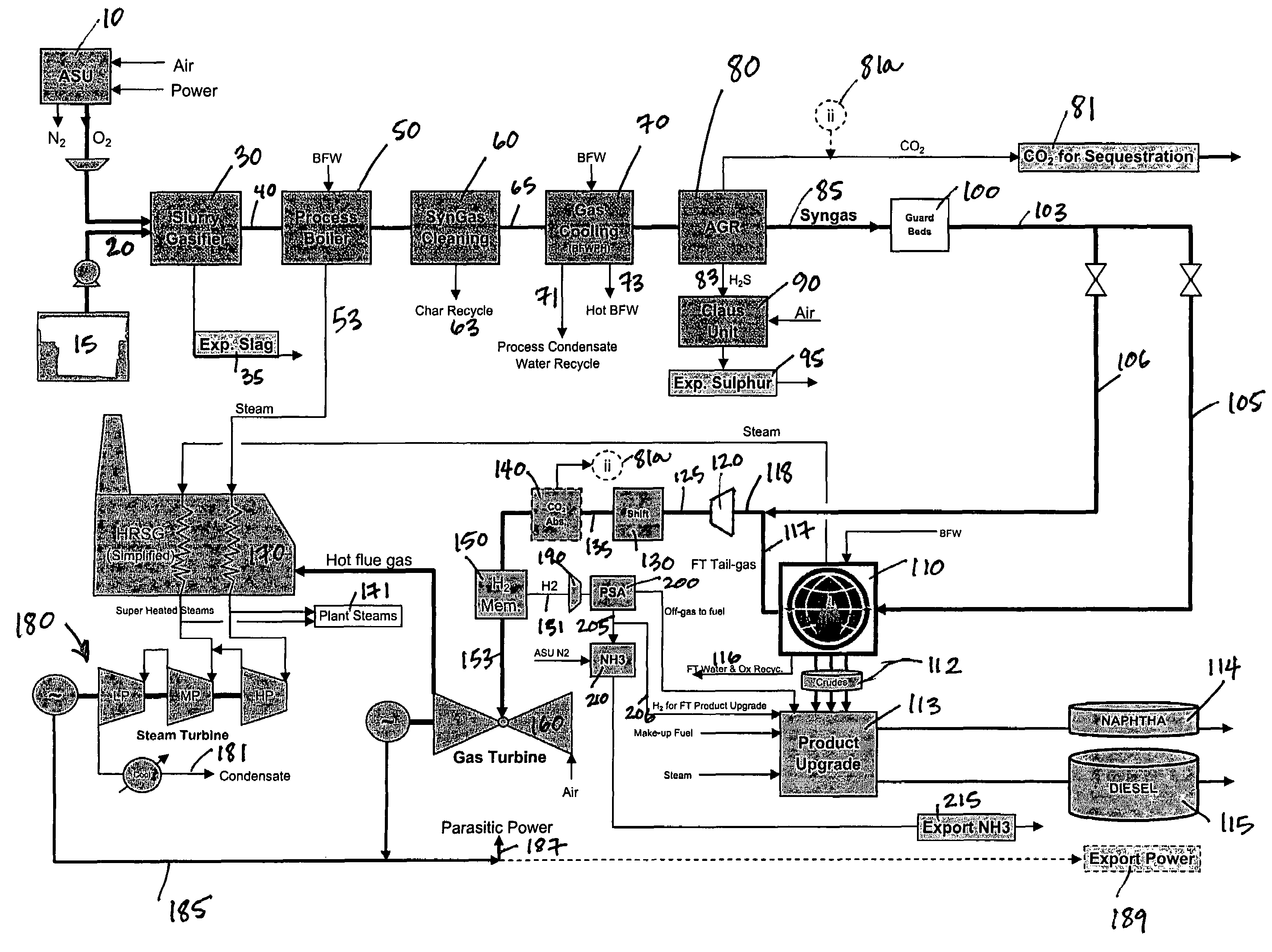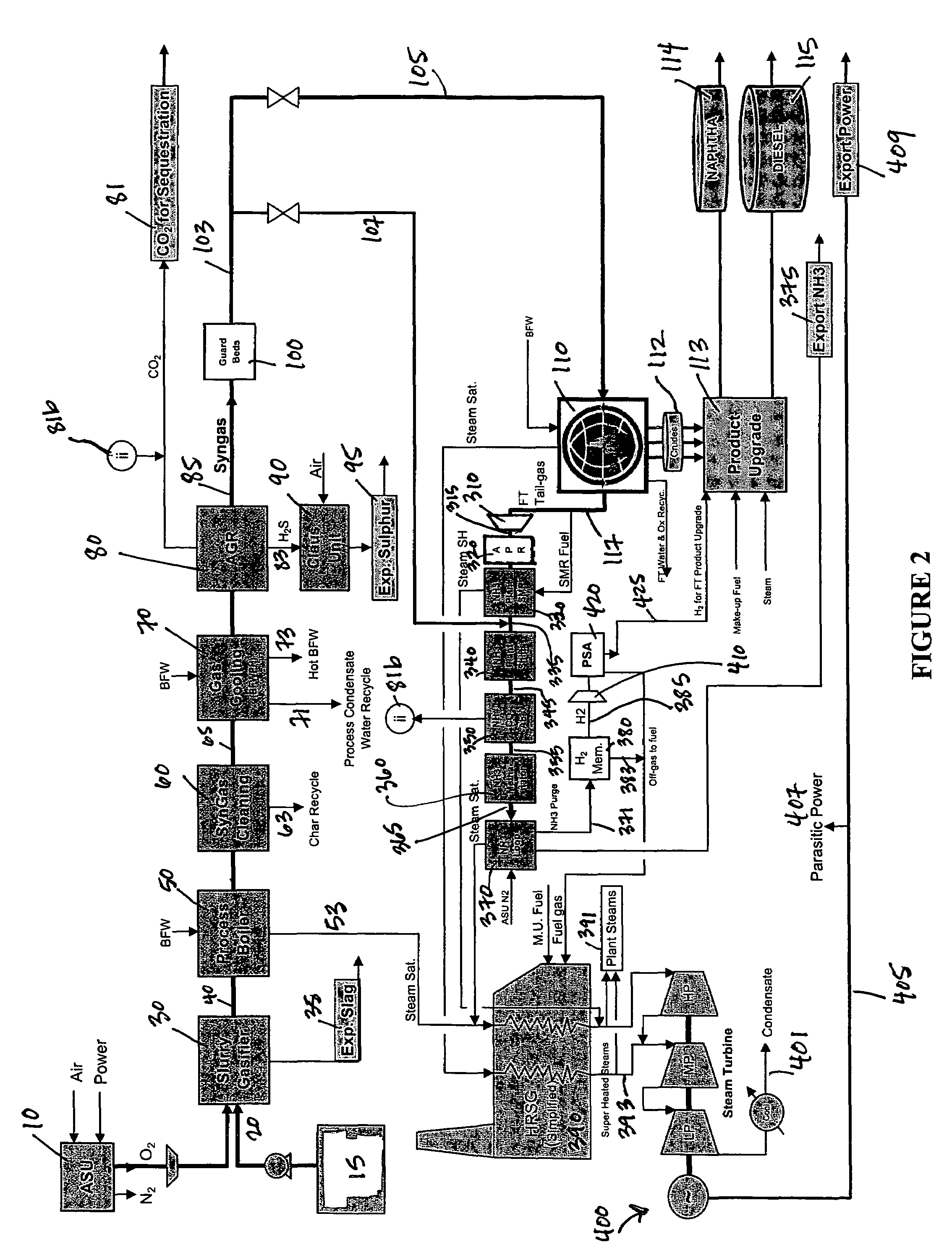Process for the production of ammonia and Fischer-Tropsch liquids
a technology of fischertropsch liquid and ammonia, which is applied in the direction of combustible gas purification/modification, sustainable manufacturing/processing, bulk chemical production, etc., can solve the problems of inability to sustain modern civilization, inability to use solid carbonaceous feedstocks requiring gasification in this system, and inability to meet the needs of modern civilization
- Summary
- Abstract
- Description
- Claims
- Application Information
AI Technical Summary
Benefits of technology
Problems solved by technology
Method used
Image
Examples
example 1
[0034]Two thousand (2,000) short tons per day of petroleum coke containing 7% moisture are gasified to produce synthesis gas comprised of hydrogen, carbon monoxide, carbon dioxide, water, methane, nitrogen and impurities. After condensing the water and removal of impurities, the remaining gases are divided into two streams. One stream is fed to a slurry Fischer-Tropsch reactor utilizing an iron-based catalyst. The tail gases from the FT reactor after liquid product removal are comprised of hydrogen, carbon monoxide, carbon dioxide, nitrogen, ethane, ethylene, propane, propylene, butane, butene, pentane, pentene, and smaller amounts of higher hydrocarbons. These tail gases are combined with the other stream bypassing the FT reactor and the combined gases are fed to a shift reactor to produce hydrogen and carbon dioxide from carbon monoxide and water. The gases from the shift reactor are fed to a hydrogen membrane separator for recovering hydrogen. The hydrogen permeate from the membr...
example 2
[0037]Five thousand one hundred and seventy (5,170) short tons per day of Wyoming powder river basin (PRB) coal containing 30% moisture are gasified to produce synthesis gas comprised of hydrogen, carbon monoxide, carbon dioxide, water, methane, nitrogen and impurities. After condensing the water and removal of impurities, the remaining gases are divided into two streams. One stream is fed to a slurry Fischer-Tropsch reactor utilizing an iron-based catalyst. The tail gases from the FT reactor after liquid product removal are comprised of hydrogen, carbon monoxide, carbon dioxide, nitrogen, ethane, ethylene, propane, propylene, butane, butene, pentane, pentene, and smaller amounts of higher hydrocarbons. Approximately 25% of these tail gases are separated for use as fuel for the steam reformer described below. Approximately 75% of these gases are compressed and fed to an adiabatic pre-reformer for removal of olefins. The gases exiting the pre-reformer are combined with steam and fed ...
PUM
| Property | Measurement | Unit |
|---|---|---|
| pressure | aaaaa | aaaaa |
| purity | aaaaa | aaaaa |
| electrical | aaaaa | aaaaa |
Abstract
Description
Claims
Application Information
 Login to View More
Login to View More - R&D
- Intellectual Property
- Life Sciences
- Materials
- Tech Scout
- Unparalleled Data Quality
- Higher Quality Content
- 60% Fewer Hallucinations
Browse by: Latest US Patents, China's latest patents, Technical Efficacy Thesaurus, Application Domain, Technology Topic, Popular Technical Reports.
© 2025 PatSnap. All rights reserved.Legal|Privacy policy|Modern Slavery Act Transparency Statement|Sitemap|About US| Contact US: help@patsnap.com



